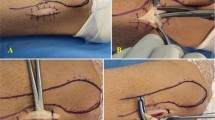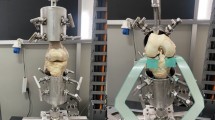Abstract
In this study knee joint function with a healing medial collateral ligament (MCL) at six weeks was examined with a robotic/universal force-moment sensor testing system during the application of two loading conditions: (1) 5 N m valgus moment and (2) 67 N anterior load. Additionally the structural properties of the femur–MCL–tibia complex and the mechanical properties of the MCL substance were determined by uniaxial tensile tests. The histological appearance of the healing MCL was also observed. At 30° and 60° of knee flexion, valgus rotation of the healing knee was significantly increased compared to the sham. The in situ force in the healing MCL was significantly lower (34±17 N vs 54±12 N) at the same flexion angles (50±10 N vs 62±7 N). The anterior translation of the knee had returned to normal values at 30° and 60° of knee flexion. However, no differences could be found between the corresponding in situ forces in the healing MCL at all flexion angles examined during application of an anterior load. The stiffness of the healing group (52.5±19.4 N/mm) was significantly lower than the sham group (80.3±26.4 N/mm) (p < 0.04). The modulus of the healing group was also significantly decreased (p < 0.05). The findings suggest that the tensile properties of the healing goat MCL and valgus knee rotation have not returned to normal at six weeks after an isolated MCL rupture, however, anterior translation appeared to return to sham levels. © 2001 Biomedical Engineering Society.
PAC01: 8719St
Similar content being viewed by others
REFERENCES
Ballmer, P. M., and R. P. Jakob. The nonoperative treatment of isolated complete tears of the medial collateral ligament of the knee. A prospective study. Arch. Orthop. Trauma Surg. 107:273–276, 1988.
Cooper, R. R., and S. Misol. Tendon and ligament insertion: A light and electron microscopic study. J. Bone Jt. Surg., Am. Vol. 52:1–20, 1970.
Ellsasser, J. C., F. C. Reynolds, and J. R. Omohundro. The nonoperative treatment of collateral ligament injuries of the knee in professional football players. J. Bone Jt. Surg., Am. Vol. 56:1185–1190, 1974.
Fetto, J. F., and J. L. Marshall. Medial collateral ligament injuries of the knee: A rationale for treatment. Clin. Orthop. Relat. Res. (132):206–218, 1978.
Indelicato, P. A. Isolated medial collateral ligament injuries in the knee. J. Am. Acad. Orthop. Surg. 3:9–14, 1995.
Jackson, D. W., E. S. Grood, J. D. Goldstein, M. A. Rosen, P. R. Kurzweil, J. F. Cummings, and T. M. Simon. A comparison of patellar tendon autograft and allograft used for anterior cruciate ligament reconstruction in the goat model. Am. J. Sports Med. 21:176–185, 1993.
Lee, T. Q., and S. L. Woo. A new method for determining cross-sectional shape and area of soft tissues. J. Biomech. Eng. 110:110–114, 1988.
Loitz-Ramage, B. J., C. B. Frank, and N. G. Shrive. Injury size affects long-term strength of the rabbit medial collateral ligament. Clin. Orthop. Relat. Res. (337):272–280, 1997.
Miyasaka, K. C., D. M. Daniel, M. L. Stone, and P. Hirshman. The incidence of knee ligament injuries in the general population. Am. J. Knee Surg. 4:3–8, 1991.
Ng, G. Y., B. W. Oakes, O. W. Deacon, I. D. McLean, and D. Lampard. Biomechanics of patellar tendon autograft for reconstruction of the anterior cruciate ligament in the goat: Three year study. J. Orthop. Res. 13:602–608, 1995.
Niyibizi, C., C. Sagarriga Visconti, G. Gibson, and K. Kavalkovich. Identification and immunolocalization of type X collagen at the ligament–bone interface. Biochem. Biophys. Res. Commun. 222:584–589, 1996.
Ohland, K. J. M., S. L.-Y. P. Woo, J. M. Weiss, S. M. Takai, and F. J. M. Shelley. AHealing of combined injuries of the rabbit medial collateral ligament and its insertions: A long term study on the effects of conservative vs surgical treatment. Adv. Bioeng. BED-20:447–448, 1991.
Oster, D. M., E. S. Grood, S. M. Feder, D. L. Butler, and M. S. Levy. Primary and coupled motions in the intact and the ACL-deficient knee: An in vitro study in the goat model. J. Orthop. Res. 10:476–484, 1992.
Reider, B., M. R. Sathy, J. Talkington, N. Blyznak, and S. Kollias. Treatment of isolated medial collateral ligament in-juries in athletes with early functional rehabilitation. A five-year follow-up study. Am. J. Sports Med. 22:470–477, 1994.
Rudy, T. W., G. A. Livesay, S. L. Woo, and F. H. Fu. A combined robotic/universal force sensor approach to deter-mine in situ forces of knee ligaments. J. Biomech. 29:1357–1360, 1996.
Sandberg, R., B. Balkfors, B. Nilsson, and N. Westling. Operative versus nonoperative treatment of recent injuries to the ligaments of the knee. A prospective randomized study. J. Bone Jt. Surg., Am. Vol. 69:1120–1126, 1987.
Shelbourne, K. D., and D. V. Patel. Management of combined injuries of the anterior cruciate and medial collateral ligaments. J. Bone Jt. Surg., Am. Vol. 77:800–806, 1995.
Visconti, C. S., K. Kavalkovich, J.-J. Wu, and C. Niyibizi. Biochemical analysis of collagens at the ligament–bone interface reveals presence of cartilage-specific collagens. Arch. Biochem. Biophys. 328:135–142, 1996.
Weiss, J. A., S. L.-Y. Woo, K. J. Ohland, S. Horibe, and P. O. Newton. Evaluation of a new injury model to study medial collateral ligament healing: Primary repair vs nonoperative treatment. J. Orthop. Res. 9:516–528, 1991.
Woo, S. L., M. I. Danto, K. J. Ohland, T. Q. Lee, and P. O. Newton. The use of a laser micrometer system to determine the cross-sectional shape and area of ligaments: A compara-tive study with two existing methods. J. Biomech. Eng. 112:426–431, 1990.
Woo, S. L.-Y., M. Inoue, E. McGurk-Burleson, and M. Gomez. Treatment of the medial collateral ligament injury II: Structure and function of canine knees in response to differing treatment regimens. Am. J. Sports Med. 15:22–29, 1987.
Woo, S. L.-Y., C. A. Orlando, J. F. Camp, and W. H. Akeson. Effects of postmortem storage by freezing on ligament tensile behavior. J. Biomech. 19:399–404, 1986.
Author information
Authors and Affiliations
Rights and permissions
About this article
Cite this article
Scheffler, S.U., Clineff, T.D., Papageorgiou, C.D. et al. Structure and Function of the Healing Medial Collateral Ligament in a Goat Model. Annals of Biomedical Engineering 29, 173–180 (2001). https://doi.org/10.1114/1.1349701
Issue Date:
DOI: https://doi.org/10.1114/1.1349701




